The best thing about using a website builder is knowing that, in a world where an online presence is absolutely mandatory, the technical proficiency to build and publish that presence isn’t.
Sure, you can sign up for web hosting, implement a template, and launch your own WordPress website. But there is an easier way. We should know: We’ve built some of our own business sites with website builders. It’s easy, fast, and unobtrusive to use an all-in-one tool.
Every one of our picks for the best website builders will help you get your site up beautifully and simply:
- Wix
Best for: Automating the tough choices - Squarespace
Best for: Beautifully designed templates - Ucraft
Best for: Building a one-page site for free - Onepager
Best for: Quick set-up
What we look for in a website builder
- Ease of use: everything’s all in one place, and it lets you get on with your real business. No technical proficiency required. No need for a designer or other outside help.
- A beautiful final product: a professional, well-designed website that reflects your business.
- Customer support: It’s there if you need it, but everything is intuitive enough that you don’t feel like you do.
We also ask questions in 5 key areas
- Style and templates
What do the templates look like?
How customizable are those templates? - Usability
How easy it is to get started?
Or, how long does it take to build a nice looking site? - Ecommerce and business needs
Can I sell things on my site?
Can I add a menu?
A form?
A map?
Reservations? - Pricing
How much does it cost?
Which tier should I start on and when will I need to upgrade?
If it’s free, what’s the trade-off? - Domains, emails, and other bonuses
Does it come with a free domain?
Does it come with email addresses?
Any other extras I should be looking for?
Our top picks for the best website builder
Wix
- Quicksprout Pick
- Best for: Automating the tough choices
- Paid plans start at $11 / month (billed annually)
- Free trial period: 14 days
- Sign up
It’s easy to choose Wix as a website builder. It truly takes on the name. Wix’s artificial intelligence asks you a few questions and literally builds your website before your eyes — unique color palette, features, and design all in one. It’s the best tool we’ve seen to get a site that matches your vision, even if you don’t know yet how you’d articulate that vision. Honestly, building a site with Wix’s AI felt a little like getting our minds read.
Wix has been at the forefront of this revolution, and is looking to closely combine AI and website building.
—Why AI is the best tool to help build your next website, TechRadar
To start, click create site. You’ll be asked a question: What kind of website do you want to create? From there, the AI will help you build your website. (You can opt-out and go it alone at this point, too, but we appreciated the AI’s help.)
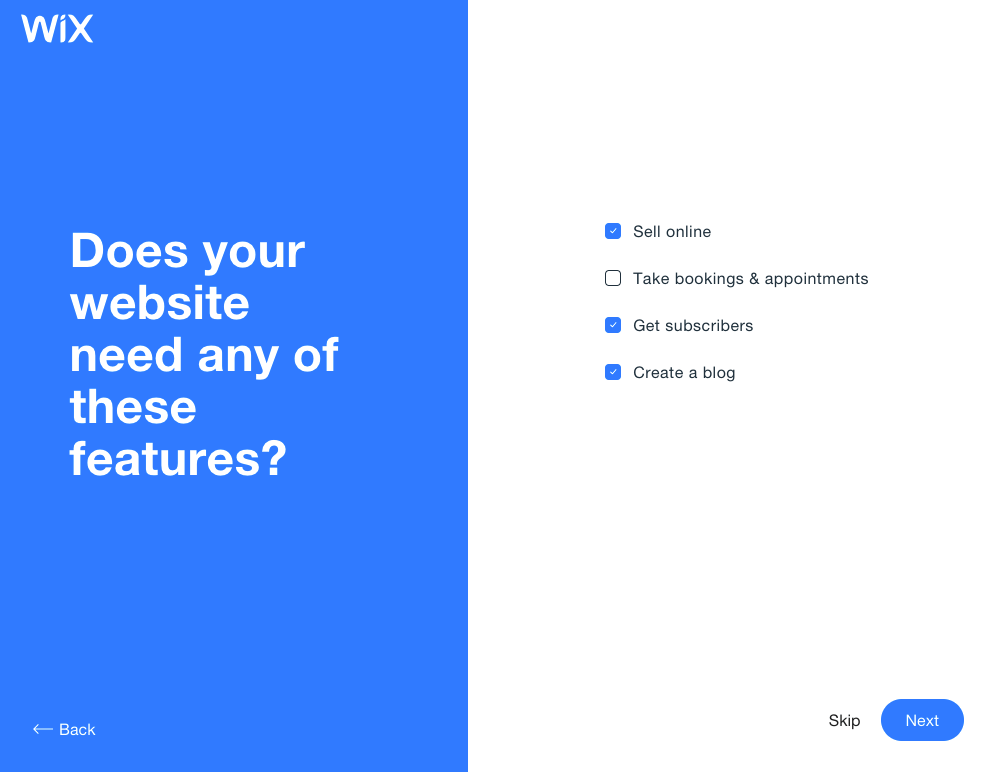
One of the first screens you’ll see when you build a website with Wix.
We loved how easy it was for us to find a template that matched our vision. The AI stayed with us as we edited the page, a little pink square in the bottom (it looks like a chat pop-up) helping us pick the next thing to edit and showing us how to do it. The Wix AI matched our business to its online presence, used our logo to create a color palette for our site, and gave us a template pre-populated with our logo and address. Connecting images from existing social media accounts made it easy to pull in all the assets we already owned.
As AI progresses, it will be harder and harder to know which site was built via AI and which was built via a designer. You can think of it like passing a “design turing test”, i.e. in the future humans will not be able to differential between the two. Then, it’ll have to get innovative. Instead of mimicking what it is learning from what’s created, it will get better and more experimental. It’s easy to see how soon most websites that are created use AI in some way.
—Wix VP & GM of Consumer Experience Nitzan Achsaf told TechRadar
There’s a lot of variety between the Wix themes, and the personality of each theme matches its name well. The Business Advisor had a spot-on graphic of an analytics dashboard, while Astrologer features an astral hero image.
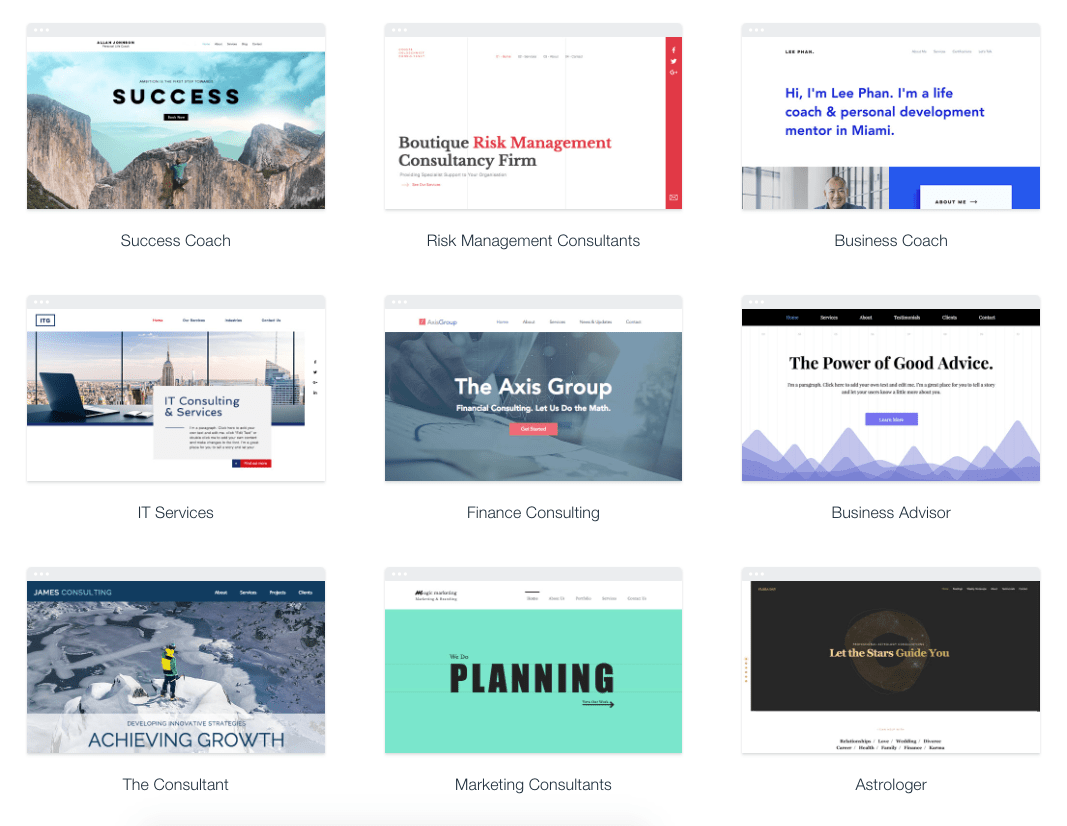
Some of Wix’s business-centric themes.
Editing your desktop site with Wix requires some patience. To change the text on a text box, you’ll need to hover precisely in the right spot. We did some deep breathing and were able to find enough inner zen to make all the changes we needed. The mobile editor has the serene helpful feel we wish the rest of the editor maintained. It’s super easy to click through the options for how your menu, quick actions, and scroll options work on your mobile page. What you change in the mobile editor doesn’t affect anything that happens on the desktop.
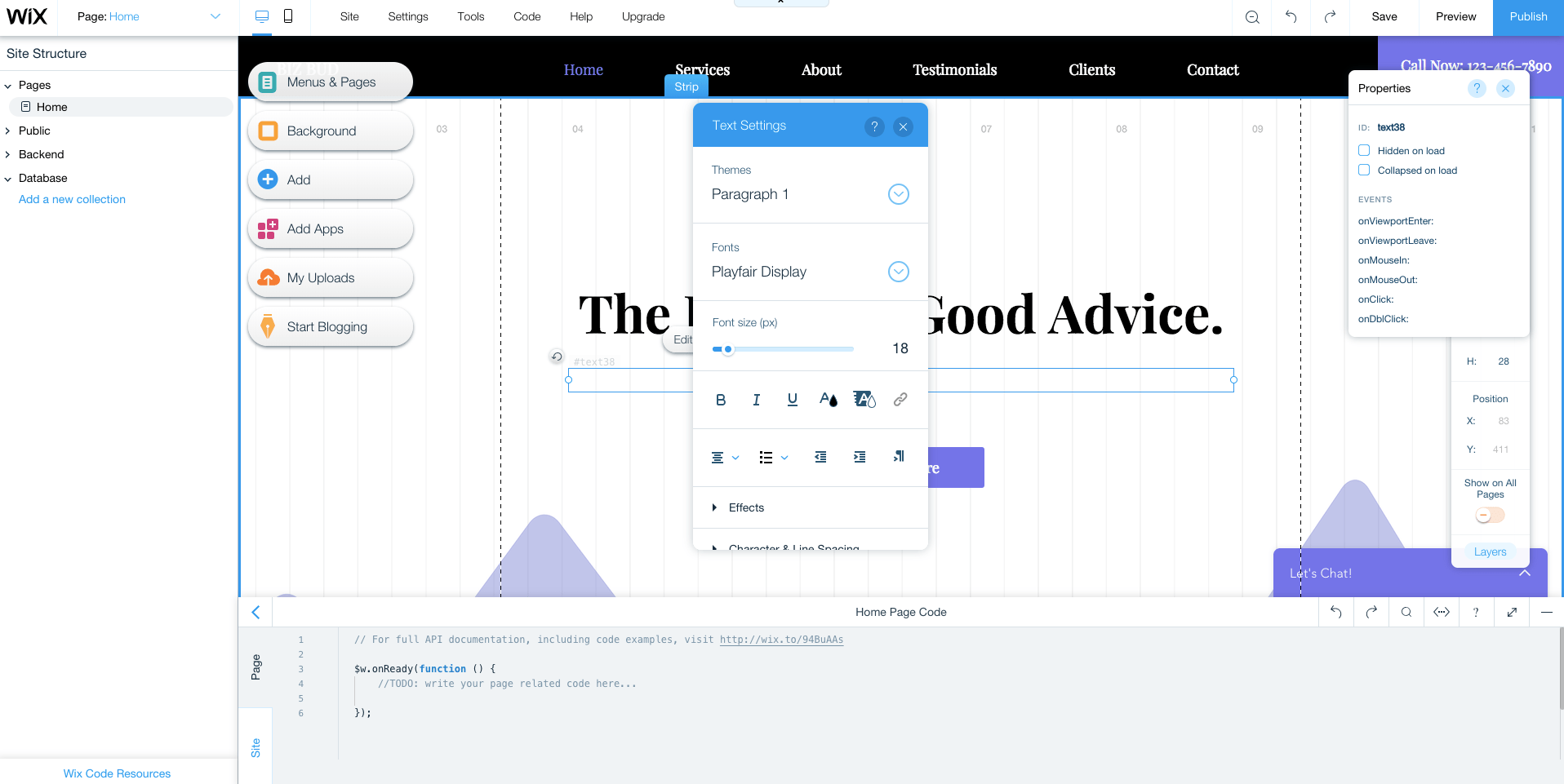
Wix’s editor requires patience — and some clicking around.
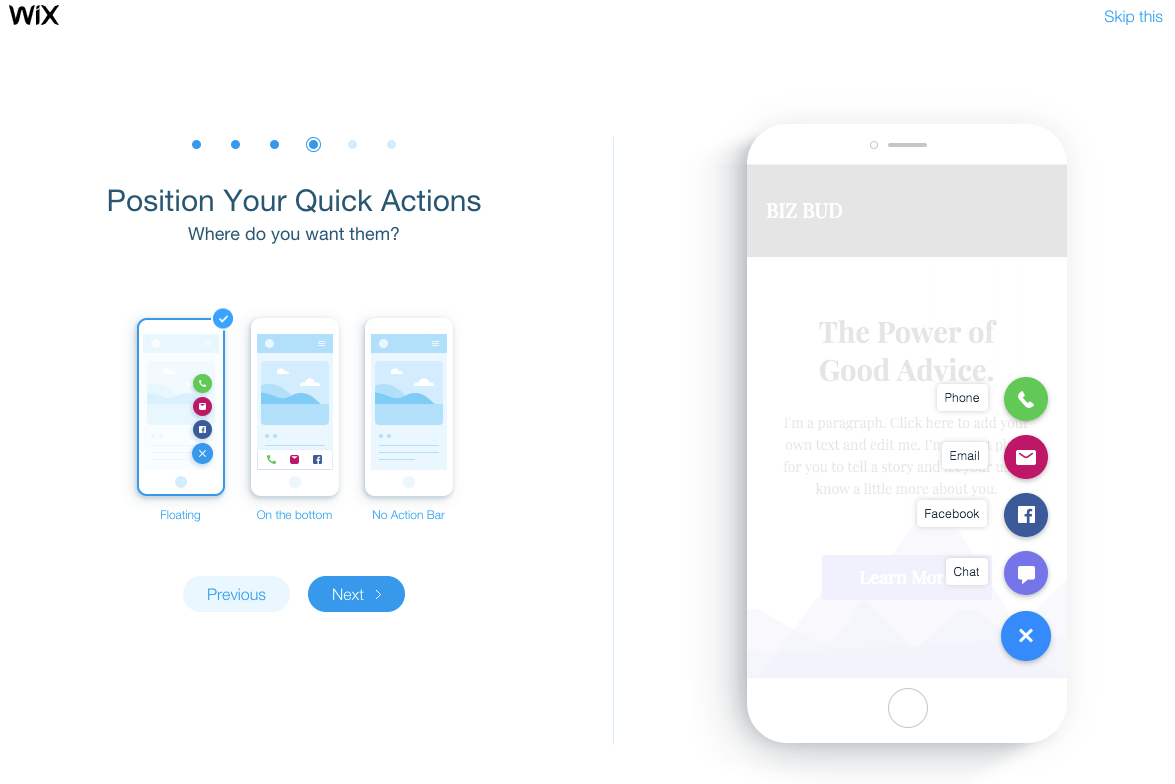
We prefer its easier-to-use mobile editor.
Wix does have a free tier, but we don’t recommend it. It has some of the most in-your-face “this was not paid for” company branding we’ve seen — an instant trust breaker. Wix free sites also have one of the most cumbersome domain structures: yourusername.wix.com/sitename so we’d be QuicksproutEditorial.wix.com/Quicksprout. Connecting your actual domain also allows you to attach a Google Analytics profile and add email accounts if you’d like ($5 / account / month, or about half that with an annual plan). Unfortunately, none of this pricing is very upfront. Wix wants you to connect your domain before you see the email pricing, for example. We found answers to pricing questions in the support center, not the user flow.
Take note: all of Wix’s plans are automatically set to auto-renew. Sticker shock is real, especially if you signed up with an introductory promo pricing (at the time of publish, premium plans were a full 50% off, for example). There are many frustrated customers on TrustPilot who’re unhappy with this. It is possible to turn off your auto-renew, but you’ll need to do it more than 14 days before your plan’s anniversary — and if you do it during your 14-day free trial, your trial will be cancelled immediately.
As for which paid plan to pick, you have 7 options: 4 “regular” and 3 “ecommerce.” The difference really boils down to whether you’ll be accepting payments on your site or not. If you’re not sure about how much bandwidth you need, you can always start with a smaller subscription: if you go over the limit, you’ll get a notice from Wix (with no penalty) and use that as your signal to upgrade.
Squarespace
- Quicksprout Pick
- Best for: Beautifully designed templates
- Plans start at $12 / month (billed annually)
- Free trial period: 14 days (plus an additional 7-day extension)
- Sign up
“Build something beautiful” is right. There’s no doubt that Squarespace wins the design and beauty contest here. The user interface has a bit of a learning curve and there’s not much of a Squarespace community to help you out, but the page you’ll end up publishing will be phenomenally good-looking.
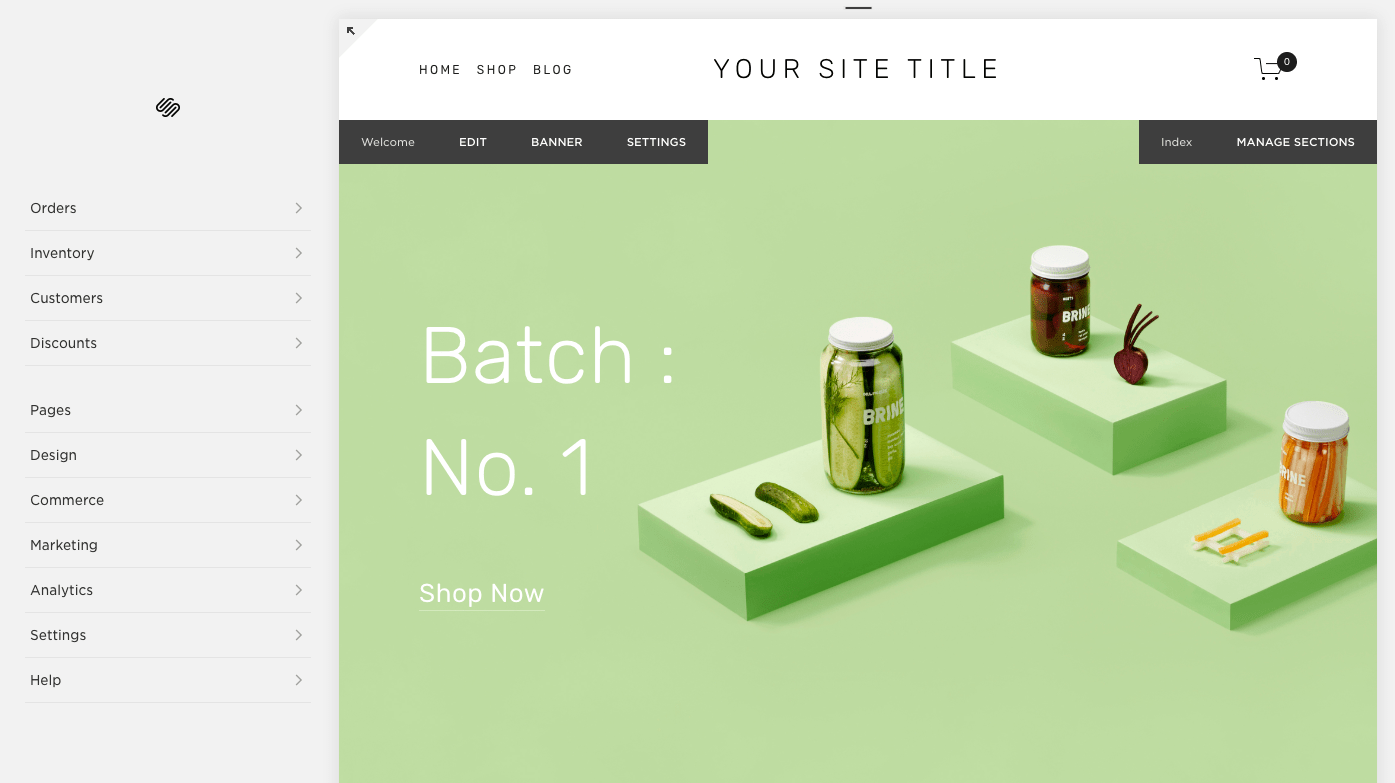
Squarespace’s templates are all modern and beautiful.
But, building a website with Squarespace can feel a little like building IKEA furniture: in the showroom it’s all so beautiful and simple, but somehow it feels a little more complicated to put together than it promised. It can be hard to understand where exactly you are in the editor. We kept getting notifications that we were editing demo content, or that we would see the social logos once we connected our social media, or that we could unlock this or that feature with a paid subscription, but Squarespace didn’t go the extra step to make it easy to make that required move. It was a lot of fumbling through a beautiful interface, not exactly sure what changes were real, or where to head next. We also had some issues saving changes — an error message popped up and we had to move on, without our changes.
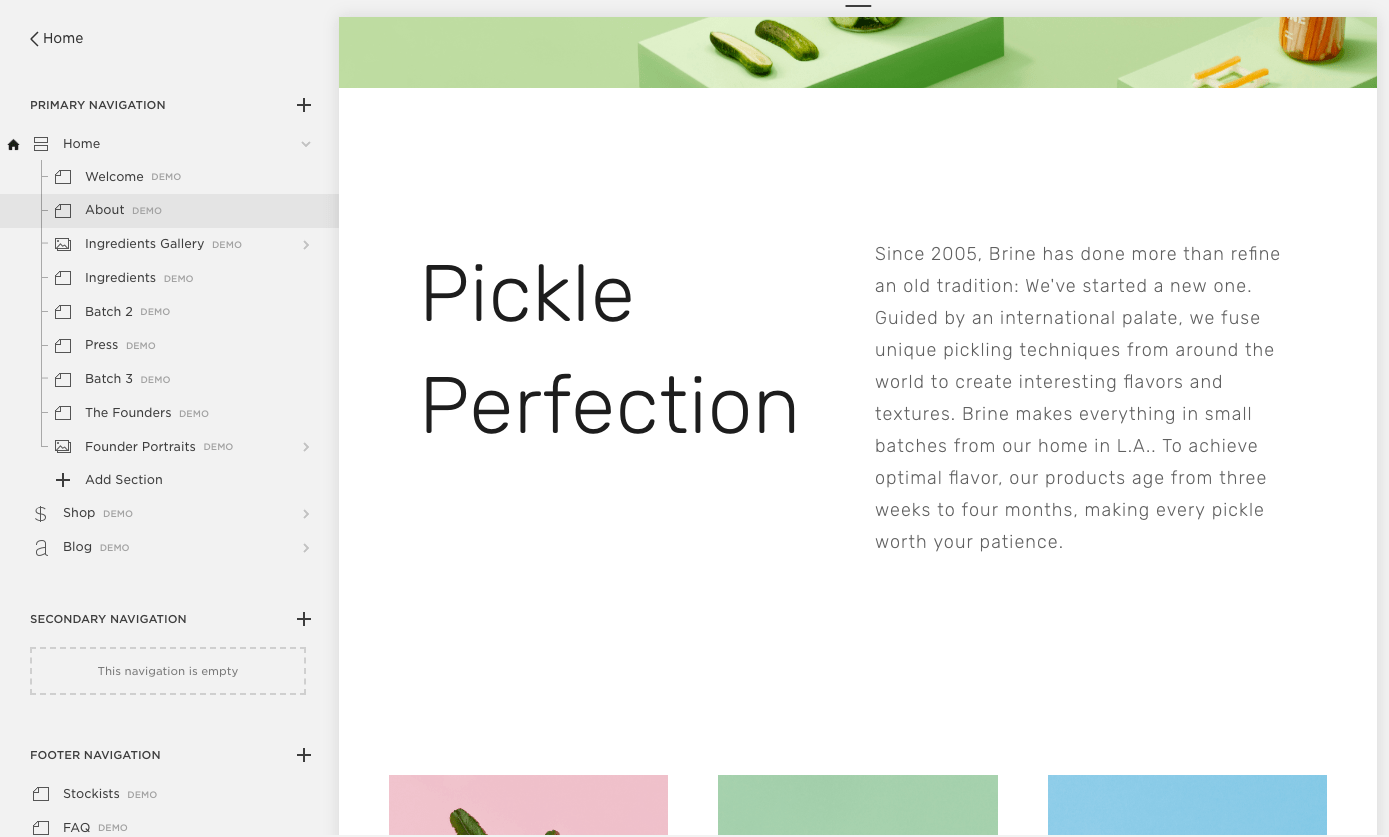
Editing a site in Squarespace has a bit of a learning curve.
Unlike IKEA, Squarespace is pricier than other website builders. That all being said, we love the way sites built with Squarespace look, and think it’s one of the simplest ways to create a beautiful, contemporary site.
Ucraft
- Quicksprout Pick
- Best for: Building a one-page site for free
- Paid plans start at $6 / month (billed annually)
- Free trial period: 14 days
- Sign up
We love the free Landing Page option from Ucraft: create a single, mobile-ready page and connect your domain for free. The free version doesn’t get rid of the Ucraft branding but it’s minimal and not invasive. The template has all the features we’ve identified in our anatomy of a high-converting landing page. You can drop the branding by upgrading to a $6 / month Basic Website plan, and sell up to 50 items on the $14 / month Pro Website plan. If you have more items to sell, upgrade again, but note that once you upgrade, you can’t drop back down to a less expensive plan.
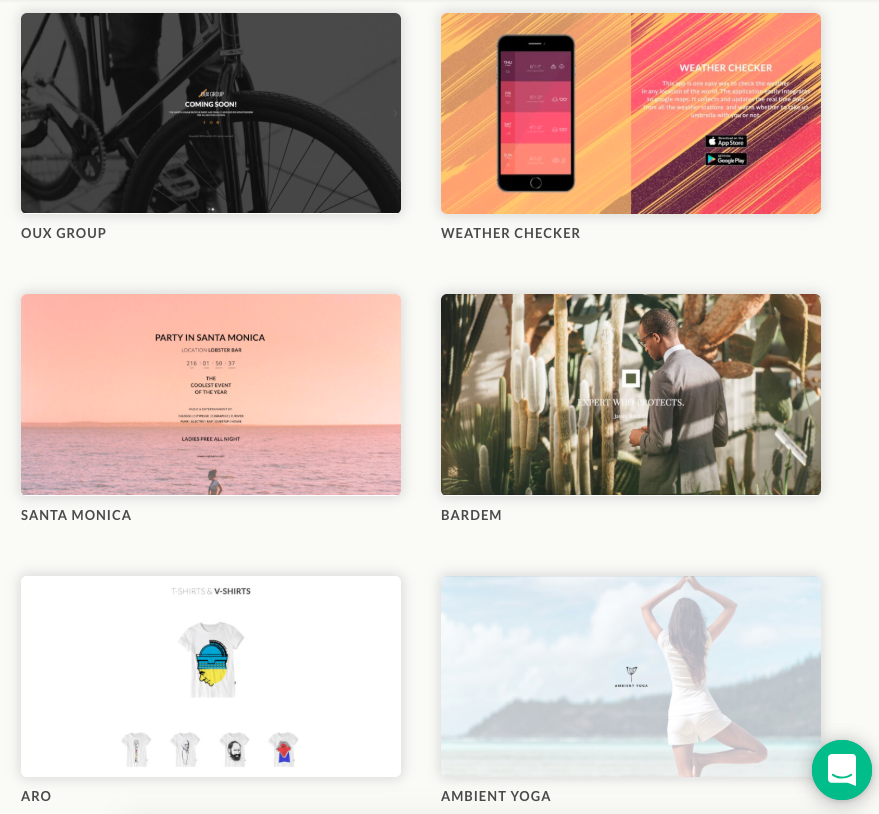
Ucraft’s themes are elegant and streamlined. It’s one-page free sites are designed to be a long scroll with anchored sections.
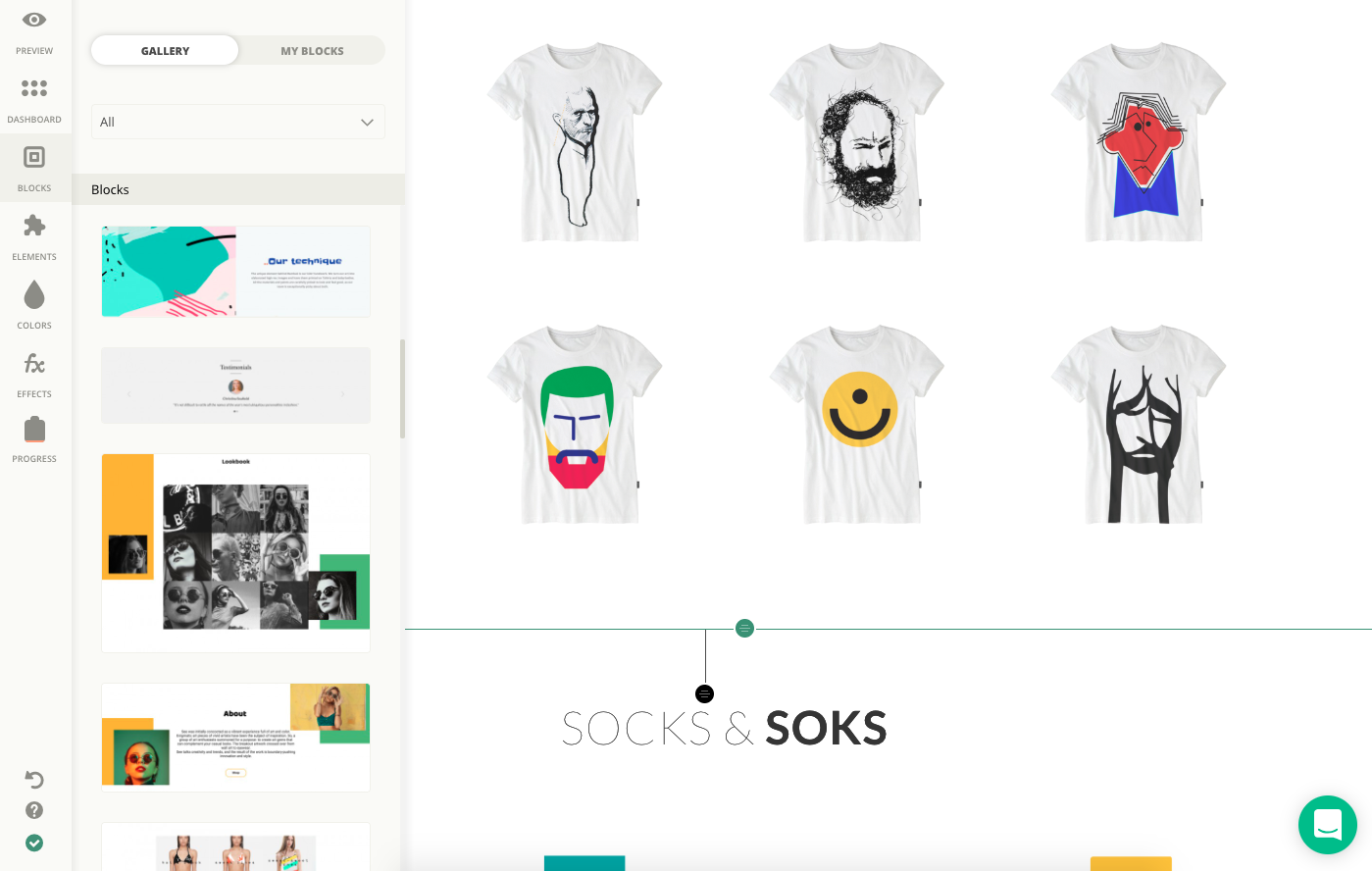
Build a Ucraft site using drag-and-drop blocks and elements.
We’re also impressed with the $229 Lifetime plan. If the subscription set up (and realization that if you love the site you build, you’ll be paying that monthly fee for… forever) isn’t your favorite, then this is a nice compromise. You still get the easy-to-use editor and tools of a website builder, and the one-and-done payment.
Onepager
- Quicksprout Pick
- Best for: Quick set-up
- Paid plans start at $8 / month (billed annually)
- Free trial period: Unlimited free editing; simply pay when you publish
- Sign up
We were so surprised to name Onepager a top pick. The templates look dated and the product tour video hasn’t been updated in six years. But Onepager is so dead simple and easy to set up that we were able to publish a workable website for a local pizza shop in minutes. Yes, every webpage builder claims you can get started that fast, but with so many options, templates, and features, we’ve found that we’re distracted and deep in the weeds of perfecting our site, not publishing it. That wasn’t the case with Onepager.
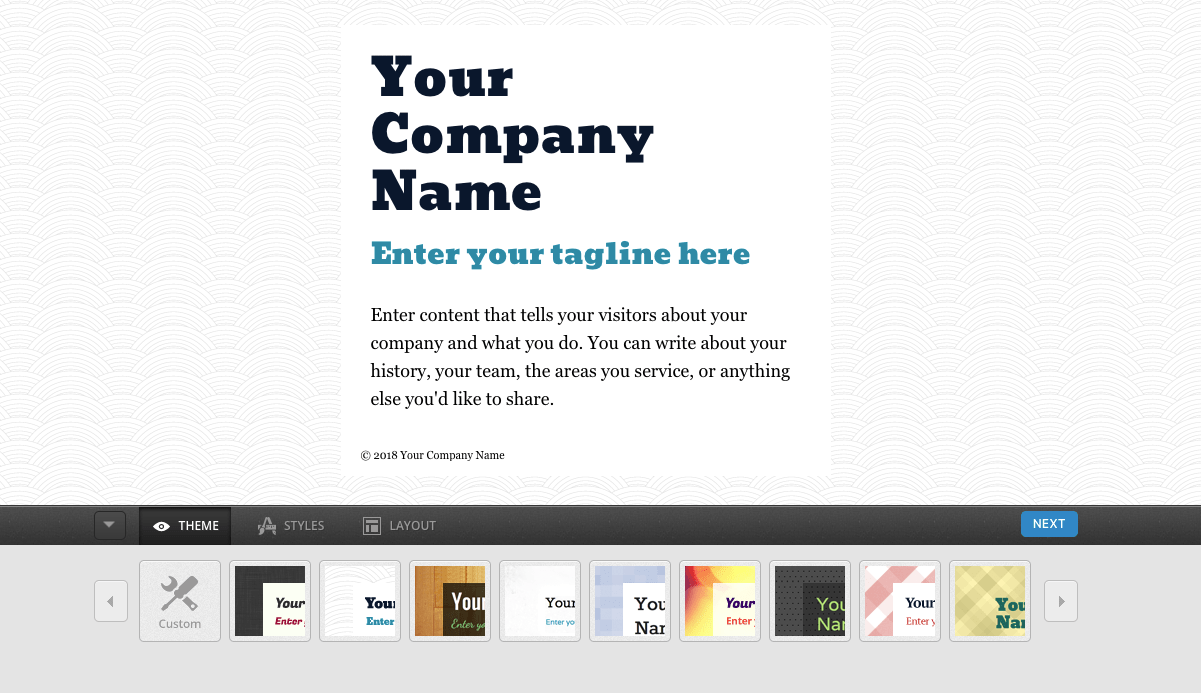
Onepager is a simple website builder with a simple interface.
The Onepager templates aren’t very modern, but they’re straight-forward and the user interface is helpful, and we were pleased with the overall look of our super-quick site. (And, as we written about before, websites with simple homepages convert better.) For a small business that just wants to stake out its territory online — as opposed to, say, building an online empire — we think Onepager fits the bill.
We’d also recommend it to anyone who gets asked all the time to build a website for a friend, a family member, so-and-so’s neighbor who has a family business. For $15 a month, you can build up to 5 sites. With the $199 per month agency plan, you can build up to 150 sites with a white-labeled version of Onepager’s editor platform.
The 26 other website builder platforms we considered
-
Adobe Muse
As of March 2018, Adobe has stopped releasing updates to its website builder software, acknowledging that simpler site builders like Wix and Squarespace have taken over: “For simpler websites, we’ve seen the emergence of Do-It-Yourself (DIY) website creators that use customizable templates to quickly create responsive websites that can be easily modified by the designer or a client.” — End of service for Adobe Muse
-
Cargo Collective
Honorable Mention Amazing templates and designs perfect for artists and art galleries, but definitely not for everyone. If you’re after templates designed for displaying images and image galleries, definitely take a look.
-
Cindr
True to its slogan, Cindr is very fast to use: add in new “blocs” and move them, but want to do much customization (say, if your team doesn’t have exactly 2, 3, 4 or 6 people on it…) and you’ll quickly get frustrated. We certainly were.
-
Duda
There were too many deal-breaker annoyances on Duda’s own website (broken links, unclear organization, scroll bars on pages that don’t scroll, and typos) for us to recommend building your site with theme. And it’s just as well, as its primary focus is on white-labeling and reselling web designs, not on creating and building your own site.
-
GoDaddy GoCentral
We’ve never loved the customer support from GoDaddy and GoCentral is no exception. There are only 8 templates, and you can only make extremely limited font and color changes on them. No moving or resizing. The GoDaddy forums are full of frustration and confusion. Case in point: GoDaddy updated live templates so their headers no longer looked the same. Support recommended changing themes if you didn’t like the new header. What a nightmare.
-
Homestead
The Homestead website itself looks like its from a different era. And the 27 featured templates from its collection of hundreds! have that same late-90s look.
-
Jimdo
We really like using an AI questionnaire to launch our website, and we adore the ease of pre-populating the images from our Google Places, Facebook, and Instagram feeds. But, Jimdo’s editor was glitchy (images would appear as blank boxes, then reappear) and the design customizations were super limited. (Is it impossible to have a full width image header without a color filter? Seems so.) Wix makes all the same promises, and delivers.
-
Moonfruit
We really wanted to love this Moonfruit. It’s clean, it’s modern, it’s easy to flip into mobile view as you edit, it has a helpful dashboard that lets you know how much of your 500 free MB storage you’ve used. And maybe it’s worth considering. But we found that the template-free starting point left us feeling more confused than empowered. The result: a lot of haphazard clicking and website that looked more amateur than any other we’d built.
-
Simvoly
Not recommended. We were intrigued by the marketing lingo Simvoly opens with: funnels, analytics, A/B testing. Oh my! But, this platform shows lots of sloppiness that keeps it out of any competition for the best: typos in the animations on the Simvoly homepage are just the beginning. The builder doesn’t have an undo/redo function, or any way to save a draft page without publishing it. Simvoly knows the right buzzwords but doesn’t back it up with its product.
-
Site123
We wanted to like the AI assistance for building our theme, but didn’t. We answered one question about our site (we’re a DJ, or a Diner) and got sent to a pre-built page for us to customize. There’s no sense of adding your own personal style or browsing through templates to pick the site structure you’d like. Want to change templates? You’ll need to go back and answer that one question differently. To get a design we liked, we felt like we had to cheat the quiz.
-
SiteBuilder
You have to sign up before you can even browse the templates. That’s a dealbreaker for us, but they also have no free plan and once the promotional pricing wears off, your cost will double.
-
SiteZulu
Not much to love here. Only 31 themes, the mobile version of our test site was buggy, and its the ecommerce “upgrade” is the free PayPal embed button.
-
SnapPages
SnapPages is one of the most expensive website builders on the market. For the price, it doesn’t offer anything you can’t get elsewhere. Recently acquired by Subsplash, we expect SnapPages to focus on selling its services as part of the Subsplash service packages aimed at churches and nonprofits.
-
Strikingly
This Y-Combinator-backed one-page web builder shouldn’t be compared to a full-fledged website builder like Wix, Weebly, or Squarespace. It’s in the simplicity of getting something launched where single-page builders work best. But, Strikingly just isn’t as good as uCraft, which lets you connect your own domain for free and has a more beautiful and user-friendly interface, or Onepager, which is so dead simple you can literally publish a complete (albeit super simple) site in minutes.
-
uCoz uKit
uCoz has a clean and modern interface, that is intuitive and easy to use (though noticeably slow to load). We didn’t love that we needed to sign up to see the templates, that most of the templates are very similar, and you’re extremely limited in editing the templates. Once you’re in a template you can’t change things like text styling and can only choose from one of three colors. This keeps you from making bad design choices, but also makes picking a template a much more important choice.
-
Virb
We don’t recommend Virb, the MySpace competitor that pivoted to become a website builder in 2010 — while the one $10 plan is simple, but there’s no way to preview the editing tool, and honestly we couldn’t even figure out how to sign up. We clicked log in (but were told we didn’t already have an account…). Let us know if you can figure it out. By watching the Virb tutorial videos on its Vimeo account, which were uploaded six years ago, we got a sense that the tool hasn’t been updated recently, and here’s the deal breaker of deal breakers: it’s not WYSIWYG. To add social buttons, you’ll need to go to a menu, click add widget, and who know where they’ll show up on the page. We live in a world with the ease of drag-and-drop editors and can’t go back.
-
Vistaprint
Vistaprint does offer some limited templates you can build yourself under its “Digital Marketing” offerings, but it’s still a business-card first business. In fact, one of the major selling points it offers is just that: your website can match your business card.
-
Voog
Voog advertises that it’s the simplest multi-lingual site builder, that is you can build your site in one language and then add all of the copy in up to 10 other languages. Your user will choose the appropriate language with the little flag logo in the corner (you can also pre-select language based on user location). But, this is a feature Wix, Squarespace, and others also offer. We think it’s better to go with one of those bigger names for a few reasons: Voog’s site itself loads very slowly with noticeable lag on pages with more than one image, and its own pricing page doesn’t automatically notice the country you’re in. When your big claim is matching content to the user country, this is a big miss.
-
Web.com
A hard no from us here. Before you even get to browse the template, you’re signing up for introductory pricing that’s $1.95 for the first four weeks, then bumps up to the “current rate” which is $22.95 a month right now, with no promise that it won’t be more later. And the fine print asserts there are 4 weeks in a month, so there are 13 “monthly” billing cycles in a year. No thanks.
-
Webnode
A simple (almost too simple) designer with a super high price point. For no ads, you’ll pay $11.95 a month on the required annual plan. At that price, you can do far better.
-
Webs
Built by three brothers and then acquired by VistaPrint in 2011 for $117.5M in cash and stock, Webs looks like it hasn’t been touched since. The editor is slow, and the templates are dated — the default “line” has the scrollwork of a fancy wrought-iron fence, for example — and the templates, which are arranged in an awkward horizontal scroll, don’t respond to the system’s filter so premium and free templates are intermingled. Can’t recommend.
-
Websitebuilder.com
A strong no. Uninspiring templates, buggy interface, a support chat portal that doesn’t work (and legitimately suggests unplugging your router to solve the problem), and terrible customer reviews that call out inaccurate billing and incorrect charges. We don’t doubt it: the terms of service say in order to unsubscribe from auto-renewals, you’ll need to turn to phone or chat, not simply update your account settings.
-
Webstarts
There’s so much freedom with Webstarts: you can literally move anything you want anywhere on the page. The problem with this is that it’s easy to move something on the desktop editor in such a way that it won’t show up on mobile. For a website builder, it’s freedom to a fault. We like to see when the software stops us from making bad decisions we don’t even know we’re making, without any fuss. Mobile-optimization doesn’t click in until the Pro Plus level, which is $14.32 a month, billed annually (~$172).
-
Weebly
In Q2 2018 Weebly was acquired by Square and has been increasingly geared towards entrepreneurs and online store owners (really gunning for online shops like Shopify). At least in its marketing, that is. When we checked out the one-star reviews on TrustPilot, we knew we couldn’t recommend Weebly. Another dealbreaker? There’s no undo button. Once you exit a module in the editor all of the changes you made are permanent. Delete a module, and want to undo it? Sorry, you’re simply out of luck.
-
WordPress.com
We love WordPress and run our site on WordPress, but an easy-to-use website builder it’s not. Dive into WordPress.com and you’ll be quickly launched into a world that feels like you need technical expertise. (You don’t really need much, but the menu layout and wiki-style simplicity feels much more demanding than others. And it most certainly is not drag-and-drop intuitive.) If you’re up to using WordPress, we recommend picking a great web host, registering a domain name, and going through WordPress.org’s “famous 5-minute installation.” You won’t pay the monthly subscription you’d pay with WordPress.com and you get all the same features — you’ll just need to do some of the hands-on work. Read more about the difference between self-hosted WordPress.org and fully hosted WordPress.com on the WordPress.com blog.
-
Yola
Yola is expensive and wants to upsell left and right. You’ll need Silver ($119 annually or $14.99 monthly) to ditch the Yola branding, and they’d like you to get Mobile Plus (an extra charge to make your business phone number and address show up on the bottom of mobile pages — this is free with Wix) and the $10/month ecommerce upgrade is simply a free Ecwid plugin Yola would love to charge for. The editor is a bit buggy, you can’t add a blog (Yola suggests embedding a Tumblr page…) and we don’t think the high price point and upselling are worth it for the mediocre product.
Recap: The best website builders
- Wix Best for automating the tough choices
- Squarespace Best for beautifully designed templates
- Ucraft Best for building a one-page site for free
- Onepager Best for quick set-up
from Quick Sprout https://ift.tt/2KGN4Mh
via IFTTT


No comments:
Post a Comment